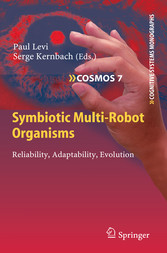Suchen und Finden
Title Page
2
Foreword
5
Acknowledgements
8
Contents
9
List of Contributors
15
Acronyms
21
Introduction
23
Concepts of Symbiotic Robot Organisms
27
From Robot Swarm to Artificial Organisms: Self-organization of Structures, Adaptivity and Self-development
27
Mono- and Multi- functional Artificial Self-organization
29
Collective Robotics: Problem of Structures
33
Adaptability and Self-development
36
Artificial Symbiotic Systems: Perspectives and Challenges
43
Towards a Synergetic Quantum Field Theory for Evolutionary, Symbiotic Multi-Robotics
47
Cooperative (Coherent) Operations between Fermionic Units
50
Individual Contributions of the Eigenanteile
58
Separate Perturbations of the Eigenanteile
62
Coupling of the Disturbed Eigenanteil Equations
64
Information Model and Interactions of Structured Components
67
Functional and Reliability Modelling of Swarm Robotic Systems
76
Macroscopic Probabilistic Modelling in Swarm Robotics
76
Reliability Modelling of Swarm Robotic Systems
87
Concluding Discussion
98
Heterogeneous Multi-Robot Systems
100
Reconfigurable Heterogeneous Mechanical Modules
100
A Heterogeneous Approach in Modular Robotics
101
Integration and Miniaturization
103
Locomotion Mechanisms
105
Docking Mechanisms and Strategies
107
Mechanical Degrees of Freedoms: Actuation for the Individual Robot and for the Organism
109
Tool Module: Active Wheel
109
Summary of the Three Robotic Platforms
112
Computation, Distributed Sensing and Communication
113
Electronic Architectures in Related Works
114
General Hardware Architecture in SYMBRION/REPLICATOR
115
General Sensor Capabilities
118
Vision and IR-Based Perception
121
Triangulation Laser Range Sensor for Obstacle Detection and Interpretation of Basic Geometric Features
126
Powerful Wireless Communication and 3D Real Time Localisation Systems
128
Integration Issues
134
Energy Autonomy and Energy Harvesting in Reconfigurable Swarm Robotics
135
Energy Autonomy
136
Energy Harvesting
137
Energy Trophallaxis
140
Energy Sharing within a Robot Organism
142
Energy Management
143
Modular Robot Simulation
154
Simulation Environments
155
The Symbricator3D Simulation Environment
158
Showcase: The Dynamics Predictor
170
Conclusion and Future Work
183
Cognitive Approach in Artificial Organisms
185
Cognitive World Modeling
185
Methodology
186
Spatial World Modeling
186
Evolution Map
187
Map
189
Jockeys
190
Reasoning
192
Executor
193
Porting the EMa onto a Robot
194
EMa Care-Taking Procedures
195
Physical Layout
196
Logical Layout and Communication
197
Experiments
199
Functional World Modelling
200
Emergent Cognitive Sensor Fusion
203
Scenarios
205
Towards Embodied and Emergent Cognition
208
Sensor Fusion Model
212
Application of Embodied Cognition to the Development of Artificial Organisms
222
Natural vs. Artificial Systems: Collectivity and Adaptability in Inanimated Nature
223
Definition of Information and Knowledge Related to Restrictions
231
Collectivity and Adaptability in Animated Nature
239
Information Based Learning to Develop and Maintain Artificial Organisms
241
Adaptive Control Mechanisms
249
General Controller Framework
249
Controller Framework in SYMBRION/REPLICATOR
249
Bio-inspiration for the Structure of Artificial Genome
252
Action Selection Mechanism
254
Overview of Different Control Mechanisms
255
Hormone-Based Control for Multi-modular Robotics
260
Micro-organisms’ Cell Signals and Hormones as Source of Inspiration
261
Related Work
266
Artificial Homeostatic Hormone System (AHHS)
267
Encoding an AHHS into a Genome
269
Self-organised Compartmentalisation
270
Evolutionary Adaptation
275
Single Robots
276
Forming Robot Organisms
277
Locomotion of Robot Organisms
279
Feedbacks
281
Conclusion
282
Evolving Artificial Neural Networks and Artificial Embryology
283
Shaping of ANN in Literature
284
Overview over Section
286
Concept of Adapting Virtual Embryogenesis for Controller Development
286
Diffusion Processes
287
Genetics and Cellular Behaviour
288
Simulated Physics
289
Cell Specialisation
290
Linkage
290
Depicting Genetic Structures and Feedbacks
292
Stable Growth due to Feedbacks in Genetic Structure
295
Developing Complex Shapes
296
The Growth of Neurons
297
Translation
298
Usability of Virtual Embryogenesis in the Context of Artificial Evolution for Shaping Artificial Neural Networks and Robot Controllers
299
Subsumption of Section
301
An Artificial Immune System for Robot Organisms
302
A Biological and Engineering Perspective
303
An Immune-inspired Architecture for Fault Tolerance in Swarm and Collective Robotic Systems
310
Innate Layer
313
Adaptive Layer
314
Summary
325
Structural Self-organized Control
326
Representation of Structures
328
Compact Representation: The Topology Generator
333
Scalability of Structures and Appearing Constraints
334
Morphogenesis as an Optimal Decision Problem
337
Self-organized Morphogenesis
342
Collective Memory and Further Points
345
Kinematics and Dynamics for Robot Organisms
346
Modeling of Multi-robot Organisms
348
Inverse Kinematics
352
Dynamics
353
Computational Analysis
355
Conclusion
356
Learning, Artificial Evolution and Cultural Aspects of Symbiotic Robotics
357
Machine Learning for Autonomous Robotics
357
Related Work
358
Challenges for ML-Based Robotics
367
The WOALA Scheme
369
First Experiments with WOALA
373
Discussion and Perspectives
381
Embodied, On-Line, On-Board Evolution for Autonomous Robotics
382
Controllers, Genomes, Learning, and Evolution
383
Classification of Approaches to Evolving Robot Controllers
384
The Classical Off-Line Approach Based on a Master EA
388
On-Line Approaches
389
Testing Encapsulated Evolutionary Approaches
392
Conclusions and Future Work
402
Artificial Sexuality and Reproduction of Robot Organisms
404
The Role of Sexuality for Robots
405
Artificial Reproduction
408
Implementation of Artificial Sexuality on Real Robots
410
Evolutionary Engineering
412
Evolution of Multicellular Organisms
417
Sex and Reproduction of Symbiotic Robots
419
Conclusion
423
Self-learning Behavior of Virus-Like Artificial Organisms
423
Effectiveness of Evolutionary Optimization for Genetic Cloud
425
Interaction between Evolution and Learning in an Evolutionary Process
432
Evolutionary Emergence of a Cooperation between Agents
438
Discovering of Chains of Actions by Self-learning Agents
441
Virus-Like Organisms: New Adaptive Paradigm ?
444
Towards the Emergence of Artificial Culture in Collective Robotic Systems
445
Project Aims
445
The Artificial Culture Laboratory
446
The Challenges and the Case for an Emerging Robot Culture
448
Robot Memes and Meme Tracking
450
Concluding Remarks
453
Final Conclusions
454
References
455
Index
485
Alle Preise verstehen sich inklusive der gesetzlichen MwSt.








